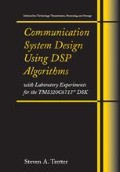This chapter begins a series on digital communications. DSP chips have made a dramatic impact on this field, initially in narrow band systems like voice-band telephone line modems and cellular telephones. In 1970, a plain 9600 bps telephone line modem was the size of a big microwave oven; contained many analog chips for filters, delay lines, and adaptive equalizer coefficient scalars; required a fan because of significant power consumption; and cost at least $15,000. It was basically just a data pump with no extra features. A few years later, medium scale integrated (MSI) digital chips were used to make a micro-coded digital signal processing unit to replace the analog functions, but the modems were still large and costly. The MSI chips included cascadable 4-bit wide ALU slices and an AMD multiplier chip. As soon as DSP chips were introduced in the early 1980's they were used to further reduce the size and cost of telephone line modems. Typically, several DSP's were required to implement a transmitter and receiver. VLSI technology rapidly improved and now a stateof-the-art V.92 56 kbps modem can be bought for less than $100 and fits in a small box or on a small card. In addition, this modem has many features like data compression, error detection and correction, trellis coded modulation, fax modes, automatic dialing, network management functions, a secondary channel, and the ability to fall back to most of the past popular telephone line modem standards ranging from speeds of 300 bps up to 33,600 bps. It is now possible to concurrently run at least 12 full duplex V.92 modems in a single state-ofthe-art DSP core and chips with multiple cores are currently being sold commercially. These high-end chips are used in remote access servers (RAS) by Internet service providers for voice over IP (VOIP) and modem pools. Because of the flexibility of the software approach to implementing signal processing algorithms with DSP's, new theoretical developments were almost instantaneously included in commercial telephone line modems. These techniques later found their way into higher speed systems that use greater channel bandwidths like high speed digital subscriber lines (DSL), microwave systems, satellite communications, and HDTV.
Access this chapter
Tax calculation will be finalised at checkout
Purchases are for personal use only
Preview
Unable to display preview. Download preview PDF.
Rights and permissions
Copyright information
© 2008 Springer Science+Business Media, LLC
About this chapter
Cite this chapter
(2008). Pseudo-Random Binary Sequences and Data Scramblers. In: Communication System Design Using DSP Algorithms with Laboratory Experiments for the TMS320C6713™ DSK. Information Technology: Transmission, Processing, and Storage. Springer, Boston, MA. https://doi.org/10.1007/978-0-387-74886-3_9
Download citation
DOI: https://doi.org/10.1007/978-0-387-74886-3_9
Publisher Name: Springer, Boston, MA
Print ISBN: 978-0-387-74885-6
Online ISBN: 978-0-387-74886-3
eBook Packages: EngineeringEngineering (R0)

